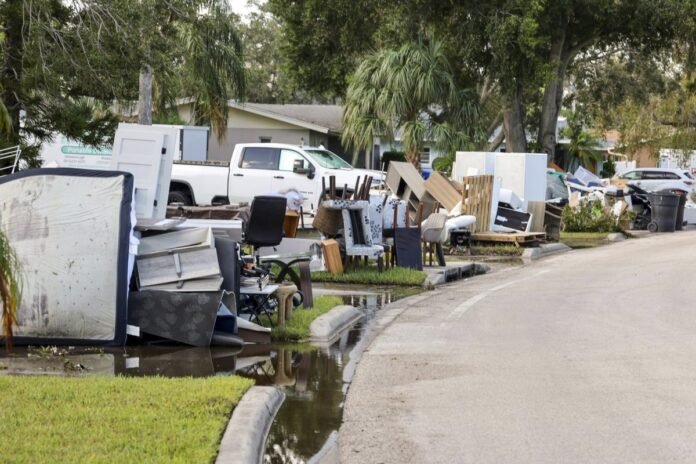A week after Hurricane Helene devastated the southeastern United States, the hardest hit homeowners are wondering how they will pay for flooding from one of the deadliest storms to hit the continent in recent history.
The Category 4 storm that hit Florida’s Gulf Coast on Sept. 26 dumped trillions of gallons of water over several states and left a trail of catastrophic destruction that stretched hundreds of miles inland. More than 200 people died in what is now the deadliest hurricane to hit the continental United States since Katrina, according to statistics from the National Hurricane Center.
Western North Carolina and the Asheville area were particularly hard hit, with flooding destroying buildings, roads, utilities and land in ways no one expected, much less prepared for.
Inland areas in parts of Georgia and Tennessee were also washed out. The Oak Forest neighborhood in south Asheville lives up to its name, with trees towering over 1960s ranch-style homes on large lots. But on Sept. 27, as Helene’s remnants swept across western North Carolina, many trees fell, sometimes landing on houses.
Julianne Johnson said she was coming up from the basement to help her 5-year-old son pick out clothes that day when her husband started yelling that a giant oak tree was falling diagonally across the yard. The tree narrowly missed the house, but still crumpled part of a metal porch and damaged the roof. Then her basement flooded, Johnson said.
On Friday, a blue tarp was held on the roof by a brick. The soaked carpet that the family had torn out lay on the side of the house, waiting to be sent to the landfill. Without cell phone service or Internet access, Johnson said she was unable to file a claim on her homeowners insurance until four days after the storm.
“It took me a while to make that call,” she said. I don’t have a compensation case yet.”
Getting by without flood insurance
Roof and tree damage is likely to be covered by the average home insurance policy. But Ms. Johnson, like many homeowners, does not have flood insurance, and she does not know how she will pay for that portion of the damage.
Those recovering from the storm may be surprised to learn that flood damage is a completely different matter. Insurance experts and experts have long warned that homeowner’s insurance policies generally do not cover flood damage to the home, although they maintain that flooding can occur anywhere it rains.
In fact, flooding is not limited to seawater seeping into the ground – it also includes water from riverbanks, as well as mudslides and torrential downpours.
However, most private insurance companies do not offer flood insurance, making the National Flood Insurance Program, operated by the Federal Emergency Management Agency (FEMA), the primary provider of this coverage for homes. Congress created the federal flood insurance program more than 50 years ago when many private insurers stopped offering policies in high-risk areas.
According to the latest FEMA data, North Carolina has 129,933 flood insurance policies, although most of those protections will likely be concentrated on the coast rather than in the Blue Ridge Mountains region, where Helene caused the most damage. By comparison, Florida has about 1.7 million flood insurance policies statewide.
Charlotte Hicks, a flood insurance expert in North Carolina who has led education and training on flood risk for the state’s insurance department, explained that the reality is that many survivors of flood ‘Helene will never be compensated. Without flood insurance, some people may be able to rebuild with the help of charities, but most others will have to fend for themselves.
“There are definitely going to be people who are going to be financially devastated by this event,” Charlotte Hicks said. It’s heartbreaking.”
Risk of bankruptcy or seizure
Some may face foreclosure or bankruptcy. Entire neighborhoods will probably never be rebuilt. There was water damage everywhere, Ms. Hicks said, and for some, mudslides even washed away the land their homes once stood on.
Meanwhile, Helene is proving to be a predictable disaster for the private home insurance market, as these plans typically only serve to cover wind damage from hurricanes.
That’s a relief for the sector, which is under increasing pressure from other increasingly intense weather disasters, such as wildfires and tornadoes. Nowhere is the shrinking private market due to climate instability more evident than in Florida, where many companies have already stopped selling insurance, making the state-backed Citizens Property Insurance Corporation the state’s largest home insurer.
Mark Friedlander, a spokesman for the Insurance Information Institute, an industry group, said Helene is a “very manageable loss event” and estimates insurer losses will be between about $5 billion and $8 billion. This compares with insured losses from Category 4 Hurricane Ian in September 2022, which were estimated at more than US$50 billion.
Mr. Friedlander and other experts point out that less than 1 percent of the inland areas that suffered the most catastrophic flooding were protected by flood insurance.
